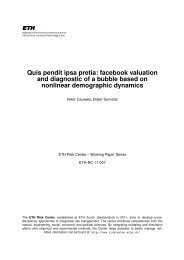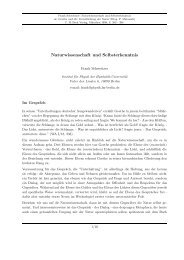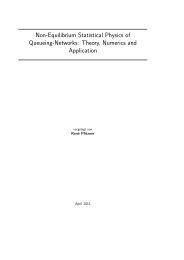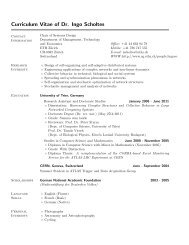Using Laboratory Experiments to Study Law and Crime - Chair of ...
Using Laboratory Experiments to Study Law and Crime - Chair of ...
Using Laboratory Experiments to Study Law and Crime - Chair of ...
Create successful ePaper yourself
Turn your PDF publications into a flip-book with our unique Google optimized e-Paper software.
financial <strong>and</strong> social investments may covary <strong>and</strong> where possible indica<strong>to</strong>rs – stability <strong>and</strong>homeownership – may also covary). But in the labora<strong>to</strong>ry we can manipulate financialinvestment <strong>and</strong> social attachment separately <strong>and</strong> observe the levels <strong>of</strong> deviance <strong>and</strong>/or informalcontrol that emerge.People <strong>of</strong>ten believe that experiments will be more useful if they look more “real” – ifthey have higher levels <strong>of</strong> mundane realism. But making a labora<strong>to</strong>ry setting more realistic mayactually reduce our ability <strong>to</strong> examine the theoretical fac<strong>to</strong>rs <strong>and</strong> mechanisms <strong>of</strong> interest (Cook<strong>and</strong> Campbell, 1979; Zelditch, 1969; see also Shadish, Cook, <strong>and</strong> Campbell 2002). As we see inphysics <strong>and</strong> chemistry, highly abstract labora<strong>to</strong>ry studies provide evidence for theories that arethen applied outside <strong>of</strong> the labora<strong>to</strong>ry in numerous substantive contexts. In the social sciences, aswell as the physical sciences, the theoretical knowledge gained in artificial settings can beapplied in the field.COLLEGE STUDENT SUBJECTSA common feature <strong>of</strong> labora<strong>to</strong>ry experiments is that they involve college studentparticipants. College students obviously differ from gang members, drug dealers, <strong>and</strong> others inmultiple ways. What can experiments with college students tell us about the behavior <strong>of</strong>criminals?The issue here is whether the theoretical causal fac<strong>to</strong>r <strong>of</strong> interest interacts with the1characteristics <strong>of</strong> the subject. Suppose that we created an experiment <strong>to</strong> test Manza’s <strong>and</strong>Uggen’s (2006) argument that disenfranchisement <strong>of</strong> felons increases recidivism. We do this bycreating groups in the labora<strong>to</strong>ry in which subjects are either granted or denied opportunities <strong>to</strong>vote for leaders who make the group’s rules. We could then look <strong>to</strong> see whether subjects weremore likely <strong>to</strong> break the rules in conditions in which they could not vote for the group’s leaders.What if we found no correlation? How would we interpret the result? We might decide that6







